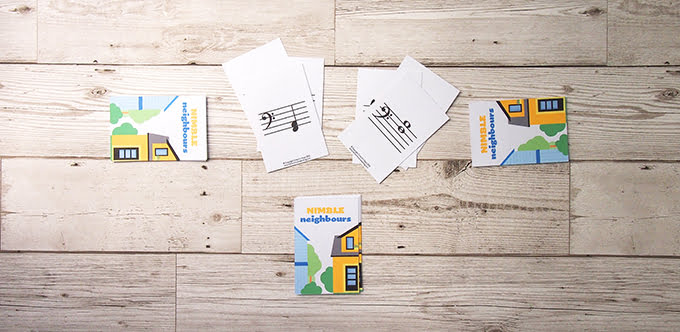
This post about improving sight reading skills in intermediate transfer piano students was written by Juanita Stauffer. Juanita teaches piano in Edmonton, Alberta, Canada. She’s been teaching for over 20 years and has an ARCT from the Royal Conservatory of Toronto. Juanita loves exploring different pedagogy methods and sharing experiences with other teachers.
Have you ever had a student like this? You’re at the initial interview or first lesson with an intermediate student. She plays a piece or two, mostly fluently. You do a few exercises and all seems well. Then you put an easy piece of music in front of her. “Could you just give this a try?” And that’s when the wheels come off the bus.

The first bar goes okay. The second bar is a bit hesitant, but she gets through it. Then she hits the third bar where the right hand is supposed to go up in 3rds. Everything slows down and it’s hunt and peck for the next two bars, until you finally take pity on the nervous student and praise her for trying it out.
What the heck just happened?
Even at that point, I tend to give students the benefit of the doubt – maybe it was just nerves. But then we start learning a new piece.
Suddenly this mostly-confident tween student starts to fall apart. It’s like she’s never read music before!
I think to myself, “But she played her pieces well!”, so I’ll assign two pieces hands-separately for the second lesson.
But next week comes, and it’s still hunt and peck through the left hand. And when I give her a sight reading piece 3-4 levels below where she is playing, it’s really rough.
It’s becoming clearer: I have a student who has managed to scrape through several years of lessons without actually being able to read fluently.
But now, at this level, memorising as she goes and faking it doesn’t work anymore.
What should we do with early-intermediate or intermediate students whose sight reading (and all of their reading, to be honest) hasn’t kept up with their ability to play music?
Diagnosing Sight Reading Issues
Before we can devise a plan to play remedial sight reading catch-up with transfer piano students, we have to know the source of the problem.
Diagnosis 1: They don’t know note names.
Does the student know the note names? If you show them flashcards, can they name and play the note in the correct octave?
This is a tricky one to diagnose with tweens and teens because once they have been playing for a number of years, they can feel embarrassed about doing flashcards like younger students.
Many students are able to name individual notes on flashcards or worksheets because they have time to use whatever method – usually mnemonics – to figure out the note names. Situations where taking a second or 2 longer isn’t really an issue.
To diagnose the note-naming nemesis, consider doing a studio-wide challenge or using an app such as Note Rush to check their note-naming savvy.
Piano Puzzle Cards
If your students need help connecting notes on the staff to the piano keys, you’ll love our Piano Puzzle cards.

Subscribe to updates and get the Piano Puzzle cards.
Enter your details to subscribe to the newsletter for piano teachers with information, tips and offers.
I hate spam as much as you do! I’ll only send you information that’s directly relevant to music teachers and you can unsubscribe at any time.
Psst! Are you a member of Vibrant Music Teaching? You can download the piano puzzle cards in one click.
Diagnosis 2: They can’t read by interval.
Let’s say your student can name and play notes with ease, but they still have trouble reading fluently. That’s when it’s time to see if they understand intervals and can spot them quickly.
I find it best to be frank about this one. Ask them if they had learnt about reading by intervals before, or if that might be something new for them.
If the student is open to playing games, pick a few which focus on intervals if you want to be more subtle about checking their interval know-how (and introducing the concept, if it’s new to them.)
Diagnosis 3: They don’t see chord patterns.
Does the student know what chords they’re looking at? Do they recognise the shapes of root position, 1st inversion and 2nd inversion chords?
A lot of intermediates can play their triads and inversions when practising their technical work, but have no understanding of what the shape of those triads look like on the page or how to name the root note and identify the quality of the chord unless it’s written in root position.
Diagnosis 4: They look at their hands too often and don’t look ahead.
Finally, students who have trouble reading often have to check their fingers to see if they’re playing the right notes. They don’t know the “feel” of different intervals under their fingers, or they’re simply not confident in their playing.
These students also tend to read one note at a time, or maybe even one beat, but they aren’t looking ahead. Just as they don’t see chord patterns if they don’t look at notes as a group, they also don’t look ahead to see what’s coming right after what they’re playing in that moment.
How to Improve Reading Skills
Once you diagnose the problem, it’s time to find the remedy for transfer piano students with sight reading woes.
Focus on Patterns
Because students with poor reading skills have often failed to understand the “roadmap” of a piece, they’ll try to sight read based on a note-by-note reading basis. So introduce pieces by helping them to see the big picture.
Start Working on Intervals
I find this is best taught within the music. I’ll start pointing out intervals like 2nds or 3rds, or ask them to point to all of one type of interval in a line of music. We’ll look for left hand chords with 5ths and 6ths and identify when they change.
It really requires a small change of vocabulary – don’t ask for the note names but ask for the intervals. You might be surprised at what they start to pick up.
Look at the Chords Together
A great way to start recognising chord patterns is to pick music which is heavily chord-based. This can be contemporary music or Classical- or Romantic-era music.
Theory pages and games can help in chord recognition, but nothing can replace identifying chords in the music.
Need help selecting repertoire? There’s a whole section about that on Nicola’s ‘Planning Lessons’ hub page.
Don’t look only for broken chords. Help your student to read the music in bigger bites – whether intervals or chords, they need to start seeing patterns so their fingers will automatically go into place.
Just be careful to pick music which has fairly simple chord patterns. After all, they won’t recognise diminished chords when they can’t even tell if it’s an A minor or C Major chord.

Naming the chords in each bar and writing them on the music can seem tedious in the lesson, and it does need to be done in smaller bites. But the more students can recognise the chords, the more they’ll be comfortable when reading.
Hunt for Repeating Bits
Whether it’s a melodic pattern, alternating intervals or a common chord progression, encourage them to find all the instances so the music becomes less daunting.
Learn About Key Signatures
Students often are able to name the key signature, but they completely miss the sharp or flat in the music. Not only do they need to know the key, but they have to see where the accidentals are.
Read from the Bottom, Up
Teach students to read and talk about intervals and chords from the bottom to the top. When they’re hesitating on a chord, I say, “read from the bottom.”

Prepare Before Playing
Instead of the hunt-and-peck method, help students to figure out what to look for before starting to play. They should know the key signature, check for accidentals, and look for repeating rhythm patterns and chord patterns. Good sight readers do this automatically – don’t assume your student knows what to look for.
Assign Regular Sight Reading
Students who are poor sight readers often skip sight reading. (Who wants to do something hard and frustrating?) Frequent sight reading makes a big difference.
However, pick your sight reading method carefully. I find that many sight reading methods are way too complicated, especially at the beginning. Look for pattern-based materials which build on skills previously learnt.
It’s also a good idea to go back several levels until you find a level where the student can play slowly without stopping.
Read Lots of Repertoire
A lot of reading practice will help students become more fluent in their reading. Whether you use the 30- or 40-Piece Challenge or you assign a “quick study” each week, just be sure to give them lots of opportunities to read music at a level which is relatively easy.
Sight Reading Motivation
We’ve diagnosed the problem and we’re working on ways to help a student get better at sight reading. But how do we motivate the student to get better?
How do we close the reading gap without discouraging them with what they see as “baby music”?
Be Honest
First, be honest, especially if it’s an older transfer student. They probably already know they can’t read very well so it’s better to have an open discussion.
Some students will be content with their reading skills, while others won’t even realise it’s something they can improve. Being honest not only helps students to be more comfortable with themselves, but can give them motivation to improve.
Choose Motivating Music
Students might not have any motivation to do what they perceive as “boring” exercises. If that’s the case, it’s probably better to incorporate new skills into their regular repertoire and try to encourage them to read and learn more repertoire so they can improve along the way.
It’s incredible to me how much students can learn when they are really motivated. Try to find out what the student really wants to play, then find a version which is accessible to them.

You can also teach them how to use lead sheets and add their own chords and accompaniments. Playing music they know can be a great motivation, and it has the added benefit of encouraging them to improvise and be freer in their playing.
Be Patient
I’ve had students who have taken two years to really improve in their reading. Their progress has seemed slow and often involves lateral moves in the same level. But at the end of a year or two, I get to point out to them how much they have learnt and how much easier the music is for them than when they first started.
These students may never be fantastic sight readers if that’s not where their natural skills lie. But at the very least we can help them to be comfortable enough in their reading to pick up whatever they want to play. And that’s great!
What are your favourite sight reading resources?
At Colourful Keys, we love Reading Railroad from the Vibrant Music Teaching library. 😍What sight reading books have you found to be most effective with transfer piano students?


What a great list! Thanks for the post. I ended up writing my own syllabus (Sight Reading Secrets) because my students needed to work on sight reading at home.
That’s really interesting feedback Rebecca on sight reading – many thanks!